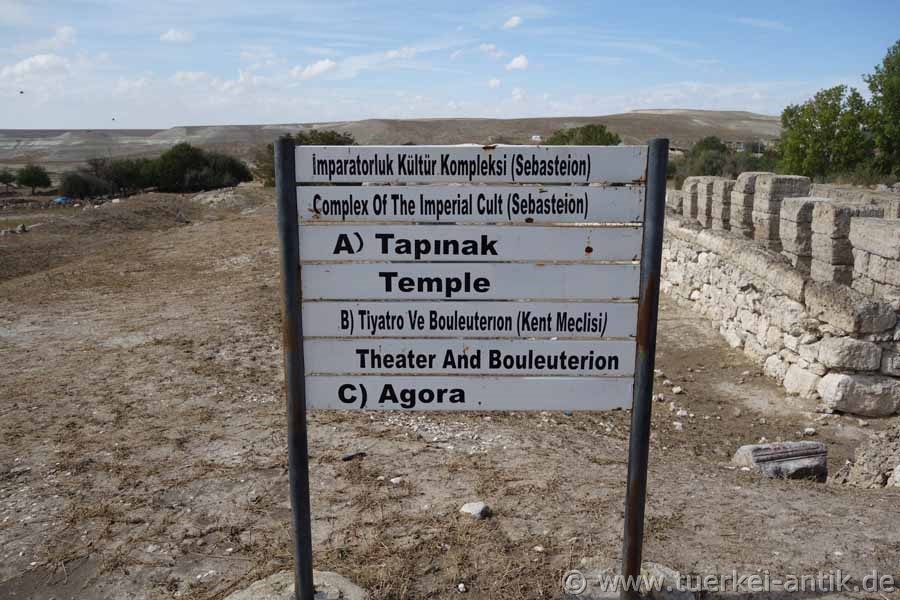 |
| The history of Pessinus |
 |
|
|
|
||
 |
|
|
|
The mythological king Midas (738-696 BC) is said to have ruled a larger Phrygian empire from Pessinus. Archaeological investigations carried out since 1967 have shown that the city developed at the earliest around 400 B.C., which contradicts any historical assertion of earlier Phrygian roots. The geographer Strabo, for example, writes that the priests were potentates in "old times". But it is not clear whether Pessinus was already a temple state which was ruled by a dynasty of priests in the Phrygian period. By the 3rd century BC at the latest, Pessinus had become a temple state ruled by a clerical oligarchy consisting of Galloi, eunuch priest of the mother goddess. After the arrival of the Celtic tribes in Asia Minor in 278/277 B.C. and their defeat during the so-called "Battle of the Elephants" (probably 268 B.C.) by Antiochus I, the Celts settled in northern Anatolia, which became known as Galatia. The Roman commitment to the Pessinus has early roots. Unsettled by several meteor showers during the Second Punic War, the Romans decided in 205/204 B.C., after consulting the Sibylline books, to introduce the cult of Kybele in Rome. The first century BC was a very unstable time for Pessinus, during which many rulers ruled over Central Anatolia. After Strabo (12.5.3) the priests gradually lost their privileges. The Mithrid wars (89-85 B.C.; 83-81 B.C.; 73-63 B.C.) caused political and economic turbulence throughout the region. When Deiotaros , Tetrarch of Tolistobogi and faithful vassal of Rome, became king of Galatia in 67/66 B.C. or 63 B.C., Pessinus lost his status as an independent, holy principality. Strabo called Pessinus an 'Emporion', a commercial centre. It can be assumed that products from the Anatolian highlands, especially grain and wool, were traded. Very soon after 25 B.C., the temple state was urbanised and transformed into a Greek polis. Constructions such as a Corinthian temple and a colonnade road ( cardo maximus ) were built with marble from the quarries in Istiklalbagi, 6 km north of the city. Inscriptions show that Pessinus owned several public buildings, including a gymnasium, a theatre, an archive and baths. A water supply system was set up through channels and terracotta pipes. The most impressive public building of the early imperial period was the sewerage system, the earliest part of which dates from Augustus. It channelled the city's sewage into the river Gallos, which crossed the city. From the 1st to the 3rd century A.D. the sewerage system was continuously extended until it finally had a length of about 500 m and a width of 11 to 13 m. The sewerage system was built in the middle of the city. It is not known exactly when the great theatre was built. It is unearthed. Today only the hollow of the cavea can be seen. It is said that the theatre was last extensively restored under Hadrian. Among the other monumental buildings erected during the reign of Tiberius was the Emperor's Cult Temple, a Sebasteion, accessible via a central staircase with two cavea wings that could be used as a theatre where religious and other performances such as gladiator fights took place. The colonnade square in the valley was reconstructed by the Belgian archaeologist Angelo Verlinde. In the past, this structure was wrongly dated to the Tiberian period. However, Verlinde was able to prove that the square had already been built in Hellenistic times (late 2nd to early 1st century BC). Christianity reached the area in the 3rd century. At the end of the 4th century the temple of Augustus was abandoned. At the end of the year 715 the town of Pessinus together with the neighbouring town of Orkistos was destroyed by an Arab invasion. The area remained under Byzantine control until it fell under Seljuk rule in the late 11th century. Then Pessinus became an inconspicuous mountain village, which was gradually depopulated. |
||
| Photo: @chim | ||
|
Translation aid: www.DeepL.com/Translator |
||
| Source: Wikipedia and others |
|
|
